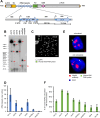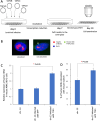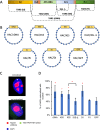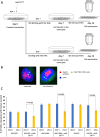Actively transcribed rDNA and distal junction (DJ) sequence are involved in association of NORs with nucleoli
- PMID: 37043028
- PMCID: PMC10097779
- DOI: 10.1007/s00018-023-04770-3
Actively transcribed rDNA and distal junction (DJ) sequence are involved in association of NORs with nucleoli
Abstract
Although they are organelles without a limiting membrane, nucleoli have an exclusive structure, built upon the rDNA-rich acrocentric short arms of five human chromosomes (nucleolar organizer regions or NORs). This has raised the question: what are the structural features of a chromosome required for its inclusion in a nucleolus? Previous work has suggested that sequences adjacent to the tandemly repeated rDNA repeat units (DJ, distal junction sequence) may be involved, and we have extended such studies by addressing several issues related to the requirements for the association of NORs with nucleoli. We exploited both a set of somatic cell hybrids containing individual human acrocentric chromosomes and a set of Human Artificial Chromosomes (HACs) carrying different parts of a NOR, including an rDNA unit or DJ or PJ (proximal junction) sequence. Association of NORs with nucleoli was increased when constituent rDNA was transcribed and may be also affected by the status of heterochromatin blocks formed next to the rDNA arrays. Furthermore, our data suggest that a relatively small size DJ region, highly conserved in evolution, is also involved, along with the rDNA repeats, in the localization of p-arms of acrocentric chromosomes in nucleoli. Thus, we infer a cooperative action of rDNA sequence-stimulated by its activity-and sequences distal to rDNA contributing to incorporation into nucleoli. Analysis of NOR sequences also identified LncRNA_038958 in the DJ, a candidate transcript with the region of the suggested promoter that is located close to the DJ/rDNA boundary and contains CTCF binding sites. This LncRNA may affect RNA Polymerase I and/or nucleolar activity. Our findings provide the basis for future studies to determine which RNAs and proteins interact critically with NOR sequences to organize the higher-order structure of nucleoli and their function in normal cells and pathological states.
Keywords: Human artificial chromosome (HAC); Nucleolar organizer regions (NORs); Ribosomal DNA; Transformation-associated recombination (TAR); rDNA.
© 2023. This is a U.S. Government work and not under copyright protection in the US; foreign copyright protection may apply.
Conflict of interest statement
The authors declare no conflict of interest.
Figures





Similar articles
-
NORs on human acrocentric chromosome p-arms are active by default and can associate with nucleoli independently of rDNA.Proc Natl Acad Sci U S A. 2020 May 12;117(19):10368-10377. doi: 10.1073/pnas.2001812117. Epub 2020 Apr 24. Proc Natl Acad Sci U S A. 2020. PMID: 32332163 Free PMC article.
-
Human NORs, comprising rDNA arrays and functionally conserved distal elements, are located within dynamic chromosomal regions.Genes Dev. 2019 Dec 1;33(23-24):1688-1701. doi: 10.1101/gad.331892.119. Epub 2019 Nov 14. Genes Dev. 2019. PMID: 31727772 Free PMC article.
-
The Relationship Between Human Nucleolar Organizer Regions and Nucleoli, Probed by 3D-ImmunoFISH.Methods Mol Biol. 2016;1455:3-14. doi: 10.1007/978-1-4939-3792-9_1. Methods Mol Biol. 2016. PMID: 27576706
-
Integrating the genomic architecture of human nucleolar organizer regions with the biophysical properties of nucleoli.FEBS J. 2017 Dec;284(23):3977-3985. doi: 10.1111/febs.14108. Epub 2017 Jun 2. FEBS J. 2017. PMID: 28500793 Review.
-
Nucleolar organizer regions: genomic 'dark matter' requiring illumination.Genes Dev. 2016 Jul 15;30(14):1598-610. doi: 10.1101/gad.283838.116. Genes Dev. 2016. PMID: 27474438 Free PMC article. Review.
Cited by
-
Transformation-associated recombination (TAR) cloning and its applications for gene function; genome architecture and evolution; biotechnology and biomedicine.Oncotarget. 2023 Dec 22;14:1009-1033. doi: 10.18632/oncotarget.28546. Oncotarget. 2023. PMID: 38147065 Free PMC article. Review.
-
Epigenetic control and inheritance of rDNA arrays.bioRxiv [Preprint]. 2024 Sep 16:2024.09.13.612795. doi: 10.1101/2024.09.13.612795. bioRxiv. 2024. PMID: 39372739 Free PMC article. Preprint.
References
MeSH terms
Substances
Grants and funding
LinkOut - more resources
Full Text Sources

